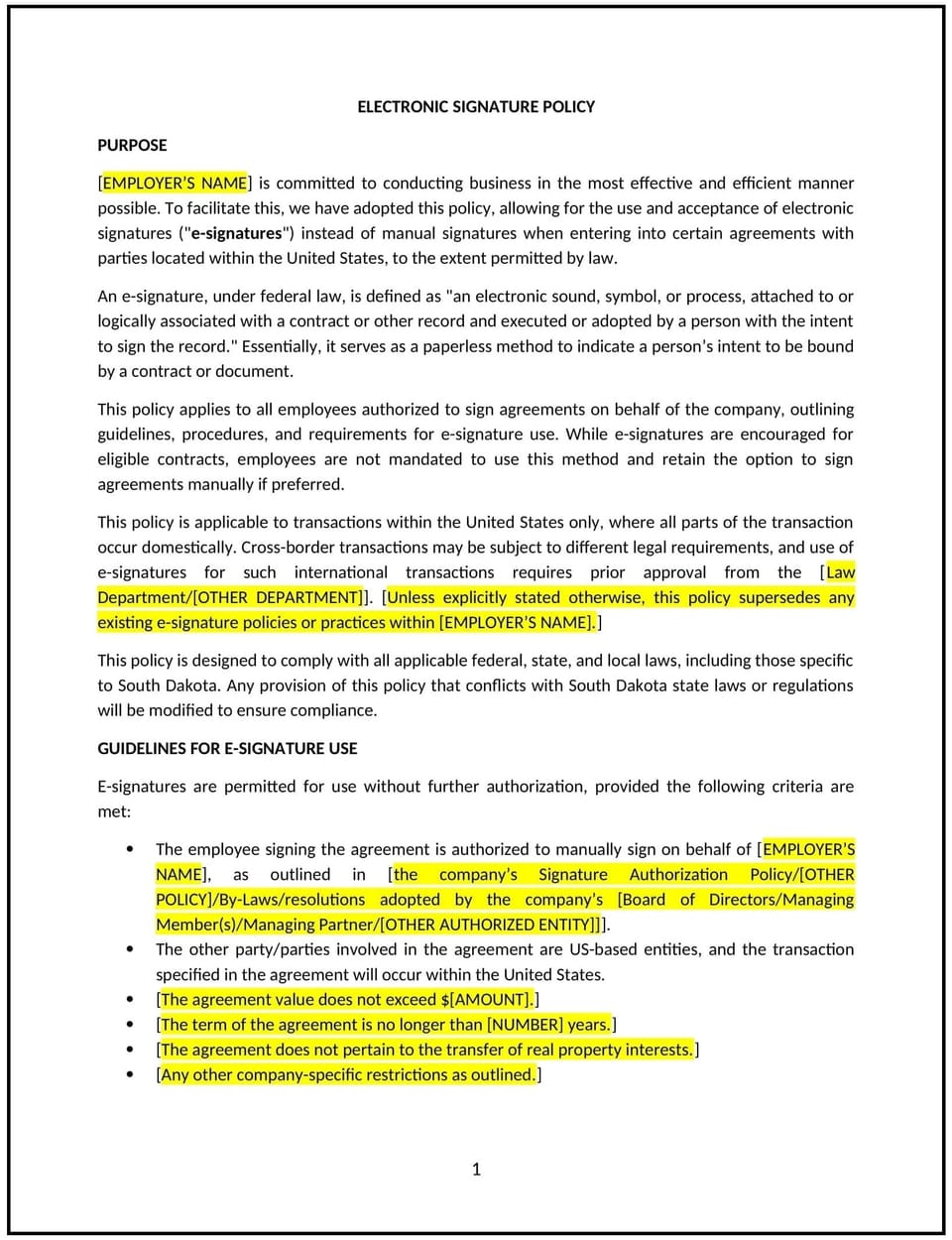Electronic signature policy (South Dakota): Free template

Electronic signature policy (South Dakota)
This electronic signature policy is designed to help South Dakota businesses establish guidelines for using electronic signatures in place of traditional handwritten signatures. It outlines procedures for creating, verifying, and storing electronic signatures to ensure legal validity and security.
By adopting this policy, businesses can streamline processes, reduce paperwork, and align with general best practices for electronic transactions.
How to use this electronic signature policy (South Dakota)
- Define electronic signatures: Explain what constitutes an electronic signature, such as a scanned image, typed name, or digital signature.
- Establish usage guidelines: Provide steps for creating and using electronic signatures, including required authentication methods.
- Address security measures: Outline procedures for securing electronic signatures, such as encryption and access controls.
- Set storage requirements: Specify how electronic signatures and related documents will be stored and retained.
- Train employees: Educate employees on following the policy and using electronic signatures securely.
- Review and update: Assess the policy annually to ensure it aligns with evolving business needs and legal standards.
Benefits of using this electronic signature policy (South Dakota)
This policy offers several advantages for South Dakota businesses:
- Streamlines processes: Reduces the need for physical paperwork and speeds up transactions.
- Enhances security: Ensures electronic signatures are created and stored securely to prevent fraud.
- Reduces costs: Minimizes expenses related to printing, mailing, and storing physical documents.
- Builds trust: Demonstrates a commitment to modern, efficient, and secure business practices.
- Supports compliance: Aligns with general best practices for electronic transactions and legal requirements.
Tips for using this electronic signature policy (South Dakota)
- Communicate the policy: Share the policy with employees and include it in the employee handbook.
- Provide training: Educate employees on following the policy and using electronic signatures securely.
- Monitor compliance: Regularly review electronic signature usage to ensure adherence to the policy.
- Address issues promptly: Take corrective action if electronic signatures are mishandled or improperly used.
- Update regularly: Assess the policy annually to ensure it aligns with evolving business needs and legal standards.
Q: How does this policy benefit businesses?
A: By using electronic signatures, businesses can streamline processes, enhance security, and reduce costs.
Q: What types of documents can use electronic signatures?
A: Electronic signatures can be used for contracts, agreements, forms, and other documents, depending on legal requirements.
Q: How should businesses ensure the security of electronic signatures?
A: Businesses should use encryption, authentication methods, and secure storage to protect electronic signatures.
Q: Can electronic signatures be used for legally binding documents?
A: Yes, electronic signatures are legally binding in most cases, provided they meet specific legal requirements.
Q: How often should businesses review this policy?
A: Businesses should review the policy annually or as needed to ensure it aligns with evolving business needs and legal standards.
This article contains general legal information and does not contain legal advice. Cobrief is not a law firm or a substitute for an attorney or law firm. The law is complex and changes often. For legal advice, please ask a lawyer.


